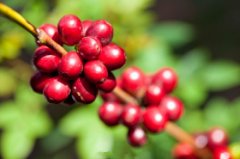Planting knowledge of Coffee trees guided by cultivation techniques of small Coffee
Small-grain coffee is a shrub of Rubiaceae, which is suitable for planting in areas with an annual average temperature of 19 ℃ ~ 21 ℃ and an altitude of 800-1400m. It has the advantages of fast plant growth, early fruit and high yield.

Land selection and preparation
Should choose a deep soil layer, loose and fertile soil, clean wind, sufficient light and shade trees, annual rainfall of 700 to 1600 mm, slope of less than 30 degrees, planting at a height of 2 to 3 meters. During reclamation, planting ditches with a depth of 60 cm and a width of 70 cm were dug, and sufficient base fertilizer was applied. Reclaim the contour platform and the backfilling of the planting ditch (hole) 2-3 months before planting. Pay attention to leaving an appropriate amount of shade trees when reclamation.
Variety selection
P3, p4 and 7963 in the Katie film series are superior, with good wind resistance, drought resistance, high yield, good quality and resistance to rust. PT is also good, but it requires higher soil fertility. In the case of multi-dry shaping, the row spacing is generally 2 × 3 m or 2.5 × 3 m, and that of single dry shaping is 1.2 × 1.5 × 2 m or 2 × 2 m. Generally speaking, the soil is fertile, the annual rainfall is high, and the species with high management level can be sparse. For coffee intercropping with coconut, betel nut, rubber or other crops, the row spacing can be determined according to the requirements of intercropping.
Timely planting
It is usually planted at the onset of the rainy season every year. If the bare roots are planted, the seedlings should be fully hydrated the day before digging. After the seedlings are dug up, the leaves should be cut off. Seedlings are best planted as they are dug. If they are to be transported far away or cannot be planted immediately, apply mud roots and put them in a cool place. Those who raise seedlings in plastic bags should cut through the plastic bags and put the seedlings into the planting hole. Do not make the soil in the bags loose, so as not to hurt the roots. The planting depth is the same as the original depth of the seedlings, and the lateral roots should be naturally stretched, pressed back to the soil, and covered with water and grass immediately after planting.
Shade
The degree of shade should vary according to different cultivation environments and varieties. When planted in tropical high-altitude areas and valleys and basins with high mountains on or around the east and west, the shade may be small or not; when growing coffee on the west slope with low humidity, strong winds, long dry seasons and strong light, the shade should be appropriately larger. The required shade is 25% to 30%. General shade requirements: 60% to 70% in seedling stage, 40% to 50% in front of fruit after planting, and 20% to 40% in peak period.
The shade tree species should have the conditions of fast growth, evergreen, sparse branches and leaves, deep main roots, few lateral roots, strong wind resistance and so on. At present, Taiwan Acacia, cherry, southwest birch and lampstand are better shade trees. The planting density of shade trees should be determined according to the size of their crowns. One can be planted every 2-3 rows and 4-5 trees between rows of coffee trees.
Shade trees are best planted in advance, and coffee trees are not planted until they can have a shade effect. Temporary shade crops can also be planted between the rows of coffee trees, such as pigeonpeas, edamame beans, pig poop beans, Tianqing and so on, which can be cut down when the permanent shade trees work.
Temporary shade trees should be thinned year by year according to different growth stages of coffee, permanent shade trees should cut off branches less than 2 meters, so as not to affect the normal growth of coffee trees, and less shade should be retained in the fruiting period, about 25% to 30%. Excess shade trees should be cut down, leaving 10 trees per mu.
Important Notice :
前街咖啡 FrontStreet Coffee has moved to new addredd:
FrontStreet Coffee Address: 315,Donghua East Road,GuangZhou
Tel:020 38364473
- Prev

Cultivation techniques of small-grain Coffee integral pruning of Coffee trees
Single trunk shaping is a method of cultivating a trunk, using the primary branch as the backbone branch and the secondary and tertiary branches as the main fruiting branch. Single-stem plastic surgery usually takes the measure of removing the top to remove the terminal bud and promote the growth of branches. ① one-time topping method: when the coffee tree is 1.5-1.7 meters high, cut off the terminal bud. There are also those who reached the top at 1.8 to 2.2 meters high. ② multiple topping method: score
- Next

General knowledge of Fine Coffee cultivation of small Coffee in Yunnan
The origin of Yunnan small-grain coffee: in 1892, the French preacher Father Tian succeeded in experimenting with growing coffee in a place called Zhu Kula in Yunnan. To the city of Guzhu Kula, there are still 24 coffee trees with more than 90 years old. Zhu Kula is a mysterious, colorful and natural village, attached to the Zhukula Village Committee, Pingdi Town, Binchuan County, Dali Prefecture, located in the trunk of the Jinsha River.
Related
- Detailed explanation of Jadeite planting Land in Panamanian Jadeite Manor introduction to the grading system of Jadeite competitive bidding, Red bid, Green bid and Rose Summer
- Story of Coffee planting in Brenka region of Costa Rica Stonehenge Manor anaerobic heavy honey treatment of flavor mouth
- What's on the barrel of Blue Mountain Coffee beans?
- Can American coffee also pull flowers? How to use hot American style to pull out a good-looking pattern?
- Can you make a cold extract with coffee beans? What is the right proportion for cold-extracted coffee formula?
- Indonesian PWN Gold Mandrine Coffee Origin Features Flavor How to Chong? Mandolin coffee is American.
- A brief introduction to the flavor characteristics of Brazilian yellow bourbon coffee beans
- What is the effect of different water quality on the flavor of cold-extracted coffee? What kind of water is best for brewing coffee?
- Why do you think of Rose Summer whenever you mention Panamanian coffee?
- Introduction to the characteristics of authentic blue mountain coffee bean producing areas? What is the CIB Coffee Authority in Jamaica?

